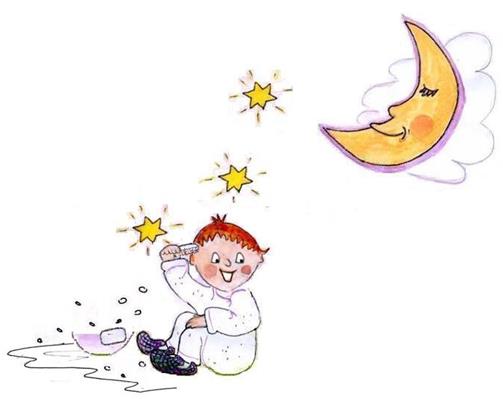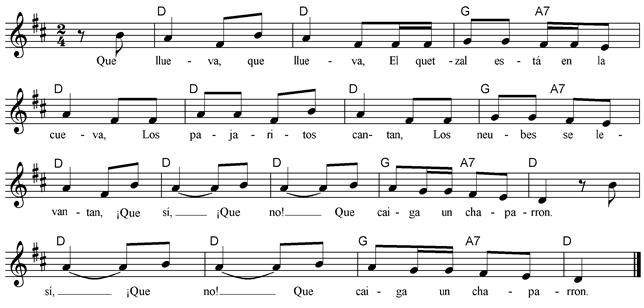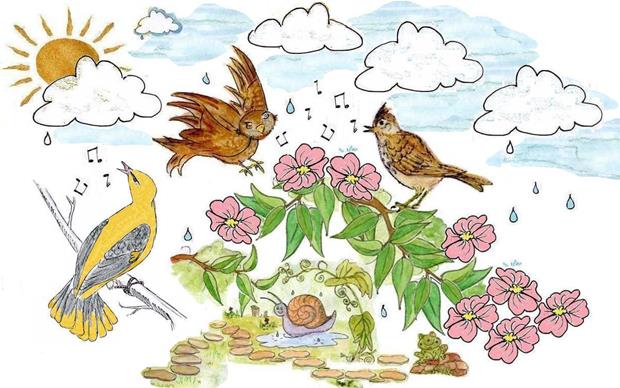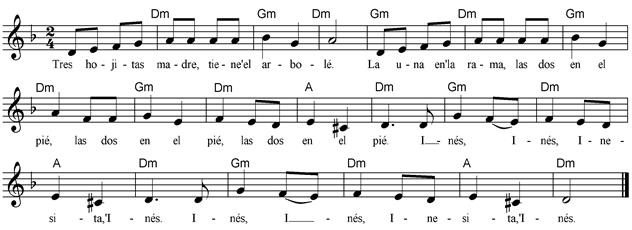 La noche,
el dia y el tiempo
La noche,
el dia y el tiempo
Al ánimo
Chiapenecas
Con el guri,
guri, guri
La araña pequeñita
Martinillo
Patatin, patatin, patatero
Pimpón
Que llueva
Tres hojita madre
Last updated: 6/28/2016
2:10 PM
The songs below are part of ‘‘La pajara pinta’ The Spanish collection
compiled, adapted, translated and illustrated by Dany Rosevear
 To listen to music from these
songs click on O
To listen to music from these
songs click on O
To watch the author
sing a song click on the title at:
Return to the ‘Singing
games for children’ home page
© Dany Rosevear 2008 All rights reserved
You
are free to copy, distribute, display and perform these works under the
following conditions:
·
you must give the original author credit
·
you may not use this work for commercial purposes
·
for any re-use or distribution, you must make clear to others the
licence terms of this work
·
any of these can be waived if you get permission from the copyright
holder
Your
fair use and other rights are no way affected by the above.
The
Spanish Collection
It is said that children who are exposed to just 50
words of a second language before to age six begin to develop an
"ear" for the sounds of that language.
It is hoped that where
possible these songs will be sung in their home language. An English version is
provided so children can enjoy the tunes before they have mastered Spanish.
Literal translations do not always make sense to the English ear so these have
been translated freely (very freely in some cases!) to complement the music and
capture the spirit of each song.
You will find more Spanish
songs in the collection ‘Away We Go’.
Spanish
pronunciation
Spoken
Spanish in both Spain and Latin America is quite distinctive from spoken
English. For that reason a few lyrics are accompanied by the sounds of the
Spanish language. The more distinctive sounds of letters in the words of the
songs are provided to aid pronunciation in the guide below. The letters not
listed are pronounced approximately as in English.
a sounds like ah (father) as
in madre
i sounds like ee (feet) as
in mi
e sounds like e (met) at the beginning or within a word as in leche
e sounds like ay at the end of a word as in leche
o sounds like oa (boat) as
in no
u sounds like oo (boot) as
in una
c sounds like th before the letters i and e as in cinco
cc sounds like ks (accident) as in accidente
j and g sounds like ch (loch) as in juego and girafa
g sounds like h (hallo)
before the letters i
and e as in gente
ll sounds like y (yard) as
in llamas
ñ sounds like ni (onions) as in señorita
qu sounds like k as
in ¿qué?
rr sounds like a Scottish r as
in arroz
v sounds
like b as in vaca
z sounds
like th (thin)
as
in arroz
h is always silent unless the word is of foreign origin
u is silent after g
and q as
in ¿qué?
In Spain ‘d’ is spoken with a lisp, this is not so
in Latin America.
There are many sites on line
that provide help with pronunciation
Spanish
punctuation
Written
Spanish in both Spain and Latin America is also distinctive from written
English; fewer capitals are used at the beginning of each line of verse,
exclamation and question marks are used both at the beginning and end of
sentences. However, for familiarity I have usually conformed to the English
model when writing Spanish verse.
Al ánimo O
In this old song from Cuba the word
‘Ánimo’, has many meanings and purposes; spirit,
courage, intention, come on, cheer up! Here a fountain is broken; variations
include a broken bridge and a fire. The concept is that no problem is too
difficult to overcome. It is sometimes played like ‘Oranges and lemons’ with
choices of heaven or hell.
Listen at:
http://www.youtube.com/watch?v=9SEnJMpt5YM
Make two rows of facing pairs.
|
Directions: The pair at the head of the row
hold hands and skip sideways up and down the set, finishing at the tail
where they hold hands high to make an arch. Those in the row clap twice
after each line.
On ‘uri,
uri, ura’ the two rows
‘peel the orange’; the pair at the front followed by the others turn to
face the head of the line. They then turn to the left or the right and skip
up the outside to meet their partner. Holding hands pairs skip through the
arch and down to their original position where they swing around.
|
|
Al ánimo,
al ánimo, la fuente se rompió, CLAP! CLAP!
Al ánimo,
al ánimo, mandarla a componer. CLAP! CLAP!
Urí, urí, urá, la estrella va a pasar,
La de adelante
corre mucho, la de atrás
se quedará.
Verbena, verbena, jazmines y azucenas, CLAP!
CLAP!
Verbena, verbena, jazmines y azucenas. CLAP!
CLAP!
Urí, urí, urá, la estrella va a pasar,
La de adelante
corre mucho, la de atrás
se quedará.
|
Step lively now, step lively now, the fountain has run dry, CLAP!
CLAP!
Step lively now, step lively now, we’ll fix it by and by. CLAP!
CLAP!
Uri, uri, ura,
there goes a shooting star,
Oh, the front is many miles away and the tail is not so far.
Verbena, verbena, sweet lily and jasmine, CLAP! CLAP!
Verbena, verbena, sweet lily and jasmine. CLAP! CLAP!
Uri, uri, ura,
there goes a shooting star,
Oh, the front is many miles away and the tail is not so far.
|
|
|
Con el guri, guri, guri O
Enjoy the wonders of the outdoors like the young pharmacist strolling
in the fresh air.
Listen at:
http://www.youtube.com/watch?NR=1&v=6Cu4TtHs0pw
Spread out individually around the room.
|
Directions:
Walk around the room in time to the music, imitating the movements
of the apothecary, sun, joy etc.
|
|
Con el guri, guri, guri,
Que lleva la boticaria,
Parece que va diciendo:
“Del junquillo sale el agua.”
Del junquillo sale el agua,
De Medina sale el sol,
De Villarcayo los rayos.
Alégrate, corazón.
Alégrate, corazón,
Aunque sea por la tarde:
Corazón que no se alegra,
Nunca cría buena sangre.
|
Hear
the tippy, tippy, tapping,
As a
young man goes a-walking,
For his
steps are surely saying:
"From
the jonquil drops the water."
From
the jonquil drops the water,
From the
east we see the sun rise,
Light
shines down on every quarter,
Cheerful
hearts will make our smiles wide.
Cheerful
hearts will make our smiles wide,
Though
it’s very nearly evening:
But a
heart that’s not contented,
Finds
the sunshine swiftly leaving.
|

|
|
La araña
pequeñita O
Learn a very familiar action rhyme in another
language.
Watch at:
http://www.youtube.com/watch?v=5YbjoDl9TMM&feature=related
|
Directions:
Place thumbs and forefinger of opposite hands together and swap up
and down to indicate climbing. Wiggle fingers raising hands high and low to
make rain. Raise hands and stretch out wide to make sunshine then wiggle
fingers upwards. Make same movement as the first line to show climbing.
|
|
La araña
pequeñita subió, subió, subió.
Vino la lluvia
y se la llevó.
Salió el sol y todo lo secó.
Y la araña
pequeñita subió, subió, subió.
|
Incy Wincy
spider climbed up the water spout.
Down came the rain and washed the
spider out.
Out came the sun and dried up all
the rain.
And Incy
Wincy spider climbed up the spout again.
|
|
Chiapenecas O
More
familiarly known in the English speaking world as the ‘Mexican hand clapping
song’; ‘Chiapenecas’ is a folk dance, from Chiapas
in Mexico sung with various Spanish and English lyrics over the last century. The words here are written to aid movement.
Find this
dance at:
http://www.youtube.com/watch?v=aok4iIGBmpE&feature=related
The Spanish
verse below has been translated with some poetic license:
Cuando la noche llegó, When night time
covers the ranch,
Y con su manto de azul, With its dark mantle of
blue,
El blanco rancho cubrió, Under the moon and the
stars,
Allegre baila empezó.
I will be dancing with you.
Make a double circle formation
facing clockwise. Each child on the outside joins hands with a member of the
inner circle.
Chorus
|
Skip round the circle
and clap,
CLAP! CLAP!
Turn
around then you skip back,
CLAP! CLAP!
Dance with your partner and clap,
CLAP! CLAP!
Move close together and clap.
CLAP! CLAP!
Dance , dance, everyone’s dancing......
|
1. Skip twice in one direction
with knees high. Clap x2.
2. Turn and skip twice the other
way. Clap x2.
3. Holding hands face partner.
Move out, in then out again. Clap x2.
4. Move in, out and then in;
outer circle claps twice behind partner’s neck, inner circle claps twice
behind partner’s waist.
Hold partner and waltz
|
|
Martinillo O
A Spanish version of ‘Frere
Jacques’, learn this song in other languages too.
Listen at: http://www.youtube.com/watch?v=VVPrp9rTCo8&feature=related
Make a single circle holding hands
standing next to a partner.
|
Directions:
Walk round in a circle first one
way then the other. On the last two lines release hands and ring bells
stretching up high and pulling down to the ground.
In the second verse turn to face
partner and bow twice. Shake hands, first right then left. Link right arms
and skip round, repeat with left arms linked.
Wave and pass each other to stand
next to a new partner.
Continue as above each time the
song is sung until original partner is encountered once again.
|

|
Martinillo, Martinillo,
Dónde estás?
 Dónde estás? Dónde estás?
Suena la campana,
Suena la campana,
Din,
don, dan!
Din,
don, dan!

Buenos
días,
buenos días,
Cómo estás?
Cómo estás?
Muy bien,
gracias,
Muy bien,
gracias,
Y usted?
Y usted?
|
 Little Martin, little Martin, Little Martin, little Martin,
Where are you?
Where are you?
In the belfry ringing,
In the belfry ringing,
Ding, ding, dong!
Ding, ding, dong!
Hey, good morning, hey, good morning,
How are you? How are you?
Very well, I thank you,
Very well, I thank you,
How about you?
How about you?
|
|
|
 Patatin, patatin,
patatero O Patatin, patatin,
patatero O
At the
start of each day greeting songs like
this one from Asuncion in Paraguay are sung in nurseries throughout South
America.
Watch at:
http://www.youtube.com/watch?v=4QfeFGf0S6s&feature=related
Sit in a circle.
|
Hello, hello, first to you and
then to me,
Play this little game and it
starts just like this: Very lightly, very slowly,
On my head I put a hat now,
See it fall; pom, pom, pom!
Pick it up and; pom, pom, pom!
Hear us sing our song together.
Hello, hello, first to you and
then to me,
Play this little game and it ends
just like this: La, la, la, la,
la, la, la!
Patatin, patatin,
patatero,
Hello children, tell me how are you, Yeah!
Patatin, patatin,
patatero,
Hello children, are you all well? Yeah!
|
Wave
palms of hands from side to side.
Point to
audience then to self.
Clap from
side to side.
Roll
hands up slowly.
Tap head
with palms of hands.
Roll
arms down. Tap floor three times.
Roll
arms up. Tap head three times.
Clap
hands together.
As first
two lines.
Clap
hands from side to side.
Roll
arms.
Stand up
and stamp feet.
On ‘Yeah!’
throw hands up in the air.
Repeat.
|
|
 Pimpón O Pimpón O
This gentle lullaby is sung at
bedtime to children in Mexico and other countries too.
Watch at:
http://www.youtube.com/watch?v=53EksB87M_o
|
Directions:
Stand in a circle and mime the
actions of the song; washing face, combing hair and shaking hands with a neighbour. For the last verse open and close fingers to
show the twinkling stars then form a pillow with hands against the cheek
and say ‘Buenas noches’
/ ‘Good night.’
|
|
Pimpón es un
muñeco,
pim-pone ace oon
moon-yea-koh
Con cara
de cartón,
cone cah-rah day cah-tone
Se lava la carita,
say ya-va la cah-ee-ta
Con agua
y con jabón, con jabón.
cone ag-wa ee
cone sha-bone
Se desenreda
el pelo,
con peine de
marfil,
Y aunque no
le gusta,
no llora, ni hace así.
Pimpón dame
la mano ,
con un
fuerte apretón,
que quiero ser
tu amigo,
Pimpón,
Pimpón, Pimpón.
Y cuando las
estrellas,
comienzan a
salir,
Pimpón se va
a la cama,
Pimpón se va
a dormir.
Buenas
noches.’
|
Pimpon he is a puppet,
His face a paper plate,
He likes to wash his round face,
With water and soap because washing is great.
Pimpón he keeps his hair so smart,
He uses
comb or brush,
Although
he doesn’t like it,
He’ll
never make a to-do or a fuss.
Pimpón he shakes his hands with me,
A big
smile on his face,
He
wants to be my favorite friend,
Pimpón, Pimpón, I will be your
best mate.
And
when the twinkling stars at dusk,
Appear
up in the sky,
Pimpón will gently close his eyes,
And
whisper quietly, ‘Good night.’ ‘Good night.’
|

|
Que llueva O
One for a wet day and similar to
the traditional English rhyme ‘It’s raining, it’s pouring, the
old man is snoring!’ Find out more about these Latin American animals and
research new ones to add more verses with their Spanish names.
Listen to a cheerful version sung
by Jose Luis Orozco from Mexico City at:
http://www.youtube.com/watch?v=D-uV3HgK-Uo
|
Directions
Two facing players form a cave
with hands held high. The others march through in single file. On the first
¡Que si! The arch falls over a child but lifts on
¡Que no! Finally a player is trapped under the arch on the syllable ‘rron’. This happens to a second child on: ¡Que si! ¡Que no! As the final phrases are repeated these
two children make a second archway.
More arches are added each time
the game is played. The latest arch drops to catch a player. The game
continues until all children are part of the cave.
|
|
Que llueva,
que llueva,
El quetzal está en la cueva,
Los pajaritos
cantan,
Los neubes
se levantan,
¡Que si!
¡Que no!
Que caiga
un chaparron.
¡Que si!
¡Que no!
Que caiga
un chaparron.
Que llueva,
que llueva,
La llama está en la cueva,
Los pajaritos
cantan,..
etc.
El cóndor está en la cueva
...And the condor sits in a dry cave....
La anaconda.../...And the anaconda...
La piraña /...And the piranha...
El tucán /...And the toucan...
El caiman /...And the caiman...
|
It’s raining, it’s pouring.
In a dry cave sits a quetzal,
The little birds are singing,
The clouds are gently rising,
Oh, yes! Oh, no!
The rain comes a-tumbling down.
Oh, yes! Oh, no!
The rain comes a-tumbling down.
It’s raining, it’s pouring.
In a dry cave sits a llama,
The little birds are singing...
In a dry cave sits a toucan…
In a dry cave sits an anaconda...
In a dry cave sits a piranha…
|
|
|
Tres hojita
madre O
Is it Autumn or is the tree
suffering from drought?
This gentle traditional song
originates from the Asturias region of Spain.
Listen at:
http://www.youtube.com/watch?v=BqabamOZ1cw&feature=related
|
Directions
Stand in a large
circle. Groups of three children are each allocated a number.
1. Child one stretches up waving branches as the other two whirl
round crouching low. On ‘Inés’
the three skip round in a circle first one way then the other.
2. As before 3. Still holding hands children two and three make a
bridge as child one flows under their arms and on to the next pair in the
large ring. On ‘Inés’ make a
new circle of three moving round first one way then the other.
|
|
1. Tres
hojitas, madre, tiene el arbolé.
La una en la rama, las dos en el pie, las dos en el pie,
las dos en el pie.
Inés, Inés, Inesita,
Inés,
Inés, Inés, Inesita,
Inés.
2. Dábales
el aire, meneábanse.
Dábales el aire, meneábanse,
meneábanse, meneábanse.
Inés, Inés, Inesita,
Inés,
Inés, Inés, Inesita,
Inés.
3. Arbolito
verde secó la rama.
Debajo del Puente retumba el agua,
retumba el agua, retumba el agua.
Inés, Inés, Inesita,
Inés,
Inés, Inés, Inesita,
Inés.
|
Three little leaves, my mother,
has the tree:
One is on the branch but two are
falling free, two are falling free, two are falling free.
Ines,
Ines, Inesita, Ines. x2
See the wind is blowing, how
those leaves do dance.
See the wind is blowing, how
those leaves do dance, how those leaves do dance, how those leaves do
dance.
Ines,
Ines, Inesita, Ines. x2
Once the tree was green but now
has branches dry.
Water flows beneath the bridge,
just hear it sigh, you can hear it sigh, you can hear it sigh.
Ines,
Ines, Inesita, Ines. x2
|
|
Return to the ‘Singing
games for children’ home page
 La noche,
el dia y el tiempo
La noche,
el dia y el tiempo![]() To listen to music from these
songs click on O
To listen to music from these
songs click on O













